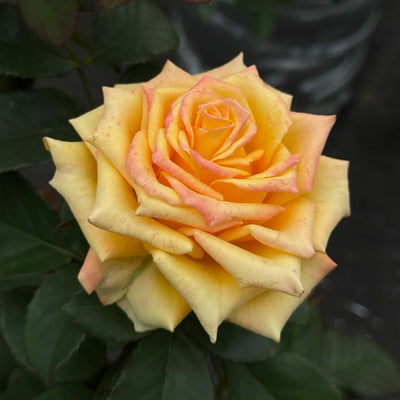Comprehensive Guide to Planting and Potting Roses: Ground and Container Methods
Growing roses can be incredibly rewarding, but many gardeners face challenges when planting and caring for their rose plants. Whether you are planting young or mature rose plants, it’s essential to follow the right methods to ensure their healthy growth. In this blog, we will guide you through the proper techniques for planting roses both in the ground and in containers, based on reliable sources from Japan.
1. Ground Planting for Young Roses
Materials Needed:
- 5 liters of dry cow manure
- 200g–300g of rose fertilizer
Steps:
- Dig a hole with a diameter of 40–50 cm and a depth of 40–50 cm. Add the dry cow manure and rose fertilizer into the hole.
- Mix some of the dug-out soil with the cow manure and fertilizer to create a base fertilizer.
- Refill the hole with the remaining soil to adjust the depth appropriately for the size of the young rose plant.
- Carefully remove the young rose from its small pot or nursery container, ensuring not to damage the roots.
- Fill the hole with soil to stabilize the plant. The soil level should not exceed the ground level. Water thoroughly.
- Once the water has drained away, level the soil.
- To prevent the graft union from being exposed or damaged, use a support stake to help stabilize the plant.
Note: The base fertilizer can also include chicken manure, sheep manure, or other organic fertilizers, which are all excellent choices.
2. Potting for Young Roses
Materials Needed:
- Hybrid tea roses, floribunda roses: 6–7 sized pots
- Miniature roses: 4–6 sized pots
- Climbing roses: 10+ sized pots
- Good drainage potting soil and large-grain akadama (volcanic clay)
Steps:
- Place a layer of akadama at the bottom of the pot for drainage.
- Position the young rose in the pot so that it occupies about 4/5 of the pot's height. The remaining 1/5 should be left for watering space.
- Carefully remove the young plant from its pot without damaging the roots.
- Fill the space around the plant with potting soil.
- Water thoroughly, ensuring that excess water drains from the bottom holes of the pot. Repeat this process 2–3 times to eliminate any air pockets in the soil.
- To prevent the graft union from exposure or damage, add a stake for support.
Note: If the graft union is wrapped with tape, leave the tape in place until it naturally loosens. For climbing roses, it's recommended to start with a larger pot since repotting mature plants can be challenging.
3. Ground Planting for Mature Roses
Materials Needed:
- 5 liters of dry cow manure
- 200g–300g of rose fertilizer
Steps:
- Dig a hole with a diameter of 40–50 cm and a depth of 40–50 cm, then add the dry cow manure and rose fertilizer.
- Mix some of the dug-out soil with the cow manure and fertilizer to create a base fertilizer.
- Fill the hole with the remaining soil, adjusting it according to the size of the rose.
- Gently separate the roots of the rose to prevent them from becoming compacted. Avoid direct contact between the fertilizer and the roots.
- Refill the hole, ensuring the soil level does not exceed ground level.
- Water thoroughly, ensuring there are no air pockets around the roots.
- After the water has drained, level the soil.
Important Tip: Always ensure that the rose roots do not come into direct contact with the base fertilizer, as it can cause root burn or damage.
4. Potting for Mature Roses
Materials Needed:
- Hybrid tea roses, floribunda roses: 7–8 sized pots
- Miniature roses: 4–6 sized pots
- Climbing roses: 10+ sized pots
- Good drainage potting soil and large-grain akadama
Steps:
- Add a layer of akadama at the bottom of the pot for proper drainage.
- Position the rose in the pot so that it occupies about 4/5 of the pot's height. Leave the remaining space (1/5) for watering.
- Separate the roots gently and place the plant in the pot. Fill around the roots with potting soil.
- Water thoroughly, ensuring that excess water drains out from the pot's bottom holes. Repeat 2–3 times to make sure there are no air pockets.
- As with young plants, provide support for the graft union to avoid injury.
Note: Be sure not to add base fertilizers to the potting mix, as mature roses do not need as much initial fertilization. If the graft union is wrapped with tape, remove it as the plant grows.
About Akadama Soil
Akadama is a volcanic soil that is widely used in rose cultivation in Japan. It is highly permeable, with a slightly acidic pH, and comes in round, reddish-brown pellets. This soil medium is effective for both water retention and drainage, ensuring that the roots receive adequate moisture while avoiding waterlogged conditions. Typically, akadama is mixed with other materials in proportions of 30–35%, and its benefits are comparable to peat moss in terms of performance.
By following these planting and potting guidelines, whether you’re growing young or mature roses, you can ensure healthy, thriving plants. With a little care and attention, your roses will flourish, adding beauty and fragrance to your garden or home. Happy planting!
















































